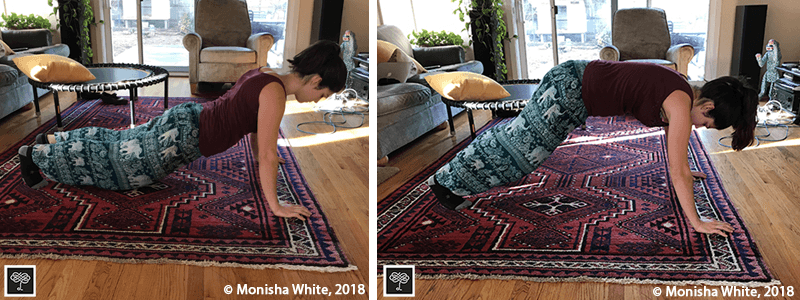How to Do a Plank Correctly
Good posture is so important for any workout or athletic endeavor. Exercise of the day: planks!
People often lose their structural integrity by dropping their hips and letting their lower back arch, or by tucking their pelvis, rounding their back, and pushing their shoulders forward.

Left: Poor form marked by dropped hips and arched back. Right: Poor form marked by rounded back and forward shoulders.
It does take more work for your abdominal muscles, particularly your internal obliques, to maintain proper form...but when you're planking, isn't that what you're going for?? Don't fool yourself into thinking you're getting a better workout by doing a longer plank with bad form!

Characteristics of a good plank include an elongated J-spine, an anteverted pelvis, and shoulders that remain back.
Keep in mind that you are a precision instrument — you have intricate parts that have a very particular baseline architecture. When you stray from the baseline and then load the structure in exercise, you may be irritating tendons, bursa, and muscles, stressing bony surfaces in ways that cause bone spurs to form, and blocking circulation. People sometimes look to exercise to fix alignment, but it’s best to focus on alignment directly to fix alignment. This is usually obvious in inanimate objects. If your car has a crooked axle, you know it needs to be fixed directly; you wouldn’t think to drive extra hard to fix the axle! It’s similar in your body — fix your alignment to make your exercise safer. And as a bonus, you’ll get more out of your exercise, too!

Comments
Thanks so much for this post!
Thanks so much for this post! Is it possible to have more of a straight line/plank position with the legs more active and the hips lower while still maintaining anteverted hips, and ribs and shoulders back? Or would tight hamstrings keep the hips from anteverting if someone tried to straighten their legs? Is that why Monisha has her hips higher and her knees soft?
I love all the information. It helps me become more aware of how I move my body.
Allison
Echoing Allison, I appreciate
Echoing Allison, I appreciate the posts, and especially posts on yoga. And my questions are the same as hers. When I look at my plank in a mirror, (after workshops with Esther and other GM teachers) I now see shoulders back, one long line in back from neck to tailbone, and straight legs, with toes tucked. I still have a slight anteversion/hip hinge, though my legs aren't bent like Monisha's. Also my knees aren't locked. This works my core even more than when I try to duplicate Monisha's good plank.
Thanks for this work!
Carolyn
Another important aspect of
Another important aspect of the plank pose, which completely agrees with the Gokhale Method, is that the toes are very active, not bent back and splayed. When one's feet are strong enough and the plank is done correctly, the weight is on or very near the tip of the toes. This makes a huge postural and energetic difference.
Thanks! Good to know.
Thanks! Good to know.
I agree with Allison's
I agree with Allison's question. Also, it's hard to see what the person in the picture is doing, given that the clothing is loose and baggy, but it's clear that the legs are not straight, and the hips are up in the air. This is not a yoga plank. Is it possible to do a classic yoga plank and maintain Esther Gokhale's methods?
Add New Comment
Login to add commment
Login